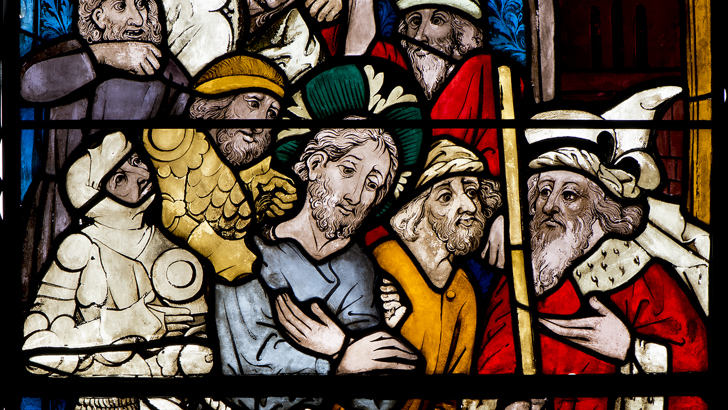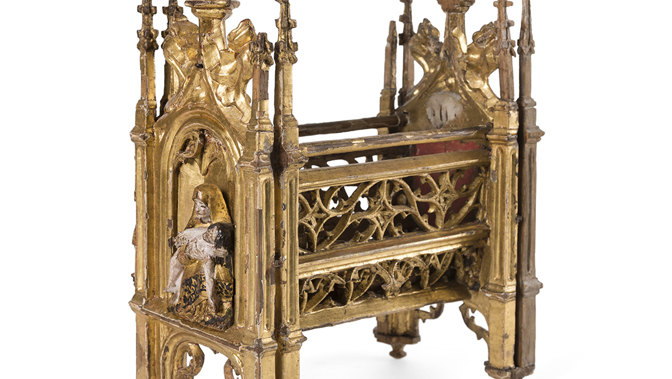To Beard or not to Beard

Alan Greenlees, Burrell Project Assistant Curator, takes a look at the importance of beards in the Middle Ages, the period between 400–1500, illustrated with examples from the wonderful stained glass in the Burrell Collection.
'In medieval Europe, facial hair wasn’t just a matter of fashion, it also had a religious and cultural significance. In the early Middle Ages beards were usually seen as a good thing, as they were associated with masculinity and maturity.
In many cultures, they were a requirement for men of the ruling classes. The Lombards, who ruled most of the Italian Peninsula from 568 to 774, are thought to have derived their name from the German word ‘Langbarte’, meaning ‘long beard’. England’s King Alfred the Great (849–99) passed a law in the 800s which fined anyone who cut off a man's beard 20 shillings.
In the 700s the monk and scholar Bede the Venerable (672/3–735) wrote ‘… the beard which is a mark of the male sex and of age, is customarily put as an indication of virtue’. This view was not universally held. A century earlier Bishop Eugenius of Toledo mocked hermits with beards, saying ‘If a beard makes a saint, nothing is more saintly than a goat’. Over time, being clean-shaven became associated with purity, humility and a celibate life, while beards came to represent sexual activity, the devil and evil.
The monk and chronicler Orderic Vitalis (1075–1142) condemned debauchery at the court of William II of England (better known as William Rufus) in the late 1000s, writing ‘Now almost all our fellow countrymen are crazy and wear little beards, openly proclaiming by such a token that they revel in filthy lusts like stinking goats.’ In 1096 the archbishop of Rouen proclaimed that bearded men should be excluded from the church, adding ‘that no one should grow his hair long but have it cut as a Christian’. In Venice, a decree banning long beards was issued in 1102.
By the 1100s the Church had forbidden monks and priests from growing beards, although the rule was not uniformly adhered to. Some clerics continued to grow beards, especially while fasting or travelling. In art of this period, monks are usually depicted without beards. In addition, saints are often shown beardless and angels are invariably clean-shaven. Paradoxically, Jesus is always depicted with a beard, and the prophets of the Old Testament mostly have one as well.


Images above:
This beardless, fresh-faced angel with curly golden hair is typical of the way angels were depicted in medieval art. While these clean-shaven monks are Cistercians, from the same order as Abbot Burchard. They have also shaved the tops of their heads in a monastic practice known as tonsure.
Stained glass panel ‘Angel carrying a column’. Made in Norwich, England, 1400s and later. (accession number 45.46)
Stained glass panel ‘Two Monks’. Made in England, 1300s. (accession number 45.35)
The no beard rule did not apply to lay brothers. These were men who lived and worked in monasteries, but who had not taken the full vows to become monks, and so were subject to less strict rules of behaviour. In the 1160s an argument about whether lay brothers should have beards broke out between the Cistercian monasteries of Bellevaux and Rosières, both in eastern France, near the border with Switzerland.
Burchard, the abbot of Bellevaux, attempted to diffuse the situation by writing a letter to Rosières entitled Apologia de barbis (In defence of beards). Writing in Latin, he referred to the study of beards as barbilogia (barbilogy) and called himself a barbilogus (barbilogist). He categorised beards into several different types, including the barba mentanea (a beard that covered the chin), the submentanea (a beard under the chin) and the barba maxillaris (a side beard). A pleniberbes was a man with an even, bushy beard, while a rariberbes was a man whose beard was thin and wispy. Late developers were called tardiberbes.
Abbot Burchard was not a fan of long beards, warning that they could become a nuisance and provoke contempt from the beardless. He was even less keen on moustaches, referring to them as ‘half-beards’ and a 'monstrous sign'. He thought that men whose moustaches reached to their ears resembled wild boar.
With gentle humour, Abbot Burchard defended the wearing of beards, concluding that a suitable, well-trimmed beard was a symbol of strength, maturity, wisdom and religious faith. His letter is the only essay devoted to beards to survive from the Middle Ages and it gives us a fascinating insight into the medieval mind.


Images above: A fine assortment of beards in a panel showing Jesus Christ being dragged in front of Pontius Pilate by two soldiers and a riotous mob.
The next panel was made for the Abbey Church of Saint-Denis, near Paris, just a few years before Abbot Burchard wrote his Apologia. It shows the Old Testament Prophet Jeremiah with a full beard.
Stained glass panel ‘Christ before Pilate’ (detail). Made in Boppard on Rhine, South West Germany, around 1440. (accession number 45.485.1.d)
Stained glass panel ‘Prophet Jeremiah’. Made in France, around 1145. (accession number 45.364)
You can see more examples of The Burrell stained glass in our collections database.
Below:
During the pandemic lockdown, inspired by this research, Alan had a go at growing a couple of fine examples of beards himself!


